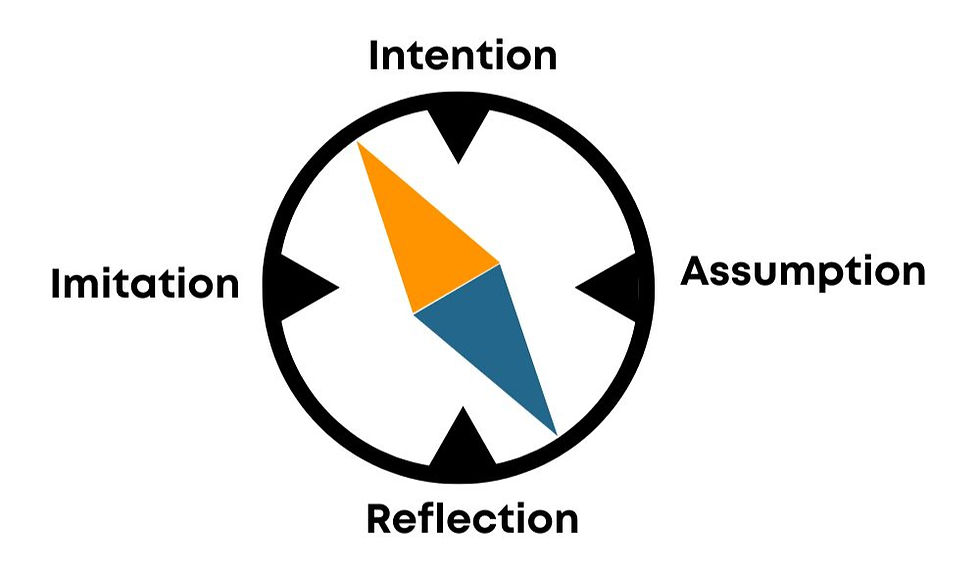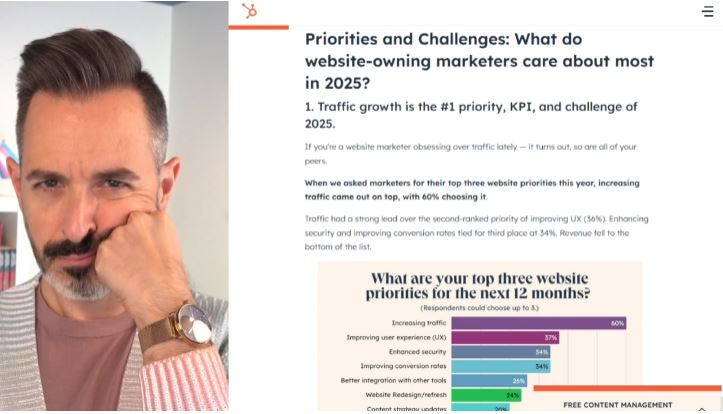Why Your “Human” Content Still Misses the Mark on AI, Metrics & Connection
- Scott Murray
- Jul 23
- 6 min read
Updated: Jul 23

These insights are featured in an episode of The Human Content Brief Podcast.
While the buzz surrounding AI is everywhere, many marketers keep insisting they’re adapting without losing the human touch. But where is the evidence?
It's actually easy to find examples that tell a very different story.
Some of the biggest blind spots are showing up in copy and content strategy - from outdated traffic goals to misused AI tools, from surface-level language to a deeper misunderstanding of what real connection looks like.
If your content isn’t hitting the mark like it used to, these five insights might explain why and what to change.
The Brand Copy Is Written By Human…But It's Not Uniquely Human
Christopher Penn did something interesting. He took a handful of marketers who regularly post about the power of human creativity and how AI can never replace great writing… and then he checked the "About" pages of their company websites.
The results? Phrases like:
“We deliver trusted insights for what’s ahead.”
“We unite a diverse portfolio of companies to deliver a full spectrum of services.”
“We are the leading turnkey solution for infrastructure management.”

Christopher’s point: If what we write sounds stiff, corporate, and interchangeable, then we’ve already lost the argument that humans bring irreplaceable value to content.
And worse, they're giving AI a competitive advantage simply because it’s cheaper at creating the same level of mediocrity.
If the work doesn’t show any craft, does it really matter if it was made by a person or AI?
👉🏻 The STAMP Framework Connection: This is a self-awareness problem.
A brand might say it values authenticity or human-centered messaging, but their language doesn’t reflect it. They're still writing copy rooted in old marketing science and that process is on autopilot.
When we look at the Self-Awareness Compass (helping us add self-awareness into the content creation process), we could avoid falling into the autopilot trap by tapping into reflection.

In this case, we reflect on existing content or newly created content and whether it:
Aligns with the needs and behaviors of people
Resembles something that looks more like marketing content or helpful communication
Exposes a flaw in internal processes, like stuck in "the way it's always been done"
It all starts with making self-awareness a bigger part of our content creation process.
Marketers Still Prioritizing Website Traffic in a Zero Click World
Speaking of awareness, a recent Hubspot Survey showed there is evidence of a lack of awareness of change. It said 60% of marketers viewed website traffic as their TOP PRIORITY in 2025.
This had Rand Fishkin looking like this:

He called it what it is: outdated thinking.
We’re no longer living in a world where ranking in Google and driving clicks back to our website is the default win.
Rand’s advice: You cannot be measuring the success of your job based on overall traffic growth.
Discovery is happening on platforms like YouTube, Reddit, LinkedIn, TikTok. Not only are people staying on those platforms - they’re not going back to your site to comment, sign up, or browse your blog archive.
As John Jantsch points out, you now have to plant your flag on “rented land.” In other words, build your presence where the audience already is. That’s how trust and conversion (yes, we’ll come back to that word) actually happen today.
👉🏻 The STAMP Framework Connection: This is all about adaptability.
Too many marketers are stuck in what worked in 2015 (and earlier) and afraid to let go. But audience behavior doesn’t pause to accommodate our comfort zones. It evolves, and we have to evolve with it.
What Does “Conversion” Mean, And Should We Use That Word?
I watched a clip from Andy Crestodina's recent interview with Matt Cornelison about what "conversion" should mean to marketers. He said:
He said: "Conversion is not about what you wanna tell them. It's about what they came to find out. And if they don't see it, guess what? A hundred percent of websites have a back button, they can go back to their previous source and there's a million options."
He pointed out that every website visitor arrives because they’re a human with a specific need or question. What matters is whether your content actually addresses that need, connects with their emotions in the moment, and provides meaningful, evidence-backed support.
And it got me thinking...
Why would marketers think it's about something we want to tell them?
Maybe the problem is we’re trying to CONVERT them to think like we want them to instead of understanding how they already think.
Is that what we would want a brand to think about when communicating with us?
As a kid of the 1980s, I think about the "conversion chamber" seen in the TV series V. Alien visitors used it to convert the minds of people so they would fight on their side.

Just as motivational speakers encourage us to change self-defeating language to improve our personal success, maybe marketing teams should do the same. Instead of chasing “conversion” as the ultimate goal, maybe we should focus on “validation.”
If a customer, client, or consumer takes the desired action, they’re validating that we met a need. And if our audience-centric goal was to create something that earned that validation, then we’ve truly succeeded.
👉🏻 The STAMP Framework Connection: This could fit into Adaptability or Predictive Intelligence.
Maybe you work in an adaptable culture that embraces human-focused content and stays open to change. Or maybe your content strategy is grounded in a deep understanding of human nature and consumer behavior, giving you the insight needed to spark the right response.
Moving Forward with AI...But Tapping the Breaks
While we still see plenty of stories about AI and content, we've also seen a new stream of conversations about needing to ensure that the rush to use it doesn't work against a business.
Sabrina Amjad works with clients across multiple industries, and she’s seeing the real-time tension between AI convenience and content quality. She said that while some businesses are seeing short-term benefits, there’s a noticeable dip in connection when AI is overused or unchecked.
She also emphasizes the importance of keeping a human in the loop. While AI can help create a base, it’s not equipped to understand tone, nuance, or audience emotion the way people can.
“AI doesn’t know your customer. You do. It doesn’t know your values. You do. If you hand everything over, you’ll lose what makes you different.”
One of her clients, for example, used AI to draft product messaging. Technically, it got the job done. But it missed subtle elements of empathy and lived experience that the audience expected and needed. When Sabrina showed them how their previous messaging had stronger emotional impact, the contrast was clear.
She’s not anti-AI. In fact, she encourages businesses to use it for idea starters or even base-level structuring, but with strong guardrails. AI becomes a problem when it’s left to operate in a vacuum, without context or correction.
👉🏻 The STAMP Framework Connection: This is also about Self-Awareness.
We see and hear about all the things that AI can do for content and marketers, especially when it comes to saving time and effort. However, if we're not aware of how our passions might blind us to how our audience might react to that content, it may not be helping us at all.
Letting AI Help Measure Your Emotional Intelligence?
At a time when our content consumers want proof of humanity while seeking to build trust and relationships, could AI help us make emotional connections?
Roger Dooley says yes.
He pointed to research from the University of Bern showing that six leading AI models (including GPT-4) actually outperformed humans on standardized emotional intelligence tests.
Wait - AI is better at emotional intelligence?
Now Roger isn’t suggesting that AI is becoming more human. Instead, he suggested that AI’s capabilities in interpreting and responding to emotional cues (when applied properly) can actually enhance our ability to communicate with emotional awareness.
“Companies using AI to enhance, not replace, their emotional intelligence will build stronger relationships,” he wrote. “Those ignoring AI emotional capabilities will keep making avoidable empathy failures.”
He also cited practical use cases where this kind of emotional support can matter:
Pre-launch communication reviews
Crisis response drafting
Stakeholder impact analysis
Customer journey emotion mapping
It’s simple: Use the tool to simulate how messages might land emotionally.
Ask how the audience might respond.
Ask about emotional gaps.
Adjust with human judgment and context.
👉🏻 The STAMP Framework Connection: This is could actually fit into all five components of the framework:
Self Awareness - - Being aware of the need to emotionally connect Two-Way Communication - Approaching content with a two-way connection mindset Adaptability - Evolving the way we create content Meaningful Language - Words that connect and resonate with your audience
Predictive Intelligence - Knowing how our audience might respond (or seeking to learn more about that)
If you'd like to listen to this episode of The Human Content Brief you can listen below or find it here.




Comments